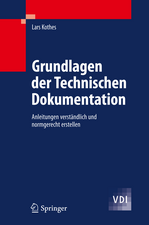Design in Nature: Learning from Trees
Autor Claus Mattheck Traducere de W. Linnarden Limba Engleză Paperback – 28 ian 1998
Preț: 893.71 lei
Preț vechi: 1089.89 lei
-18% Nou
Puncte Express: 1341
Preț estimativ în valută:
171.03€ • 177.48$ • 142.95£
171.03€ • 177.48$ • 142.95£
Carte tipărită la comandă
Livrare economică 17-31 martie
Preluare comenzi: 021 569.72.76
Specificații
ISBN-13: 9783540629375
ISBN-10: 3540629378
Pagini: 292
Ilustrații: XIV, 276 p. 193 illus., 118 illus. in color.
Dimensiuni: 155 x 235 x 18 mm
Greutate: 0.52 kg
Ediția:1998
Editura: Springer Berlin, Heidelberg
Colecția Springer
Locul publicării:Berlin, Heidelberg, Germany
ISBN-10: 3540629378
Pagini: 292
Ilustrații: XIV, 276 p. 193 illus., 118 illus. in color.
Dimensiuni: 155 x 235 x 18 mm
Greutate: 0.52 kg
Ediția:1998
Editura: Springer Berlin, Heidelberg
Colecția Springer
Locul publicării:Berlin, Heidelberg, Germany
Public țintă
ResearchCuprins
The Minimum on Mechanics.- What Is a Good Mechanical Design?.- The Axiom of Uniform Stress and How Computer Methods Derive from It.- The Mechanics of Trees and the Self-Optimization of Tree Shape.- The Right Load Distribution: The Axiom of Uniform Stress and Tree Shape.- Annual Rings: The Internal Diary as a Consequence of the External Situation.- Wood Fibres and Force Flow: The Fear of Shear Stress.- How Does a Tree Break?.- Can Trees Really Not Shrink?.- Bones: Ultra-Light and Very Strong by Continuous Optimization of Shape.- Bone Design: Selected Examples.- Bony Frameworks and Tree Frameworks Compared.- Claws and Thorns: Shape-Optimized by Success in the Lottery of Heredity.- Biological Shells.- Bracing: Ultra-Light but Highly Specialized.- Shape Optimization by Growth in Engineering Design.- Unity in Diversity: Design Target and Realization.- Critique on Optimum Shape: Sensitization by Specialization.- Outlook: Ecodesign and Close-to-Nature Computer Empiricism.- New Examples of Application in Self-Explanatory Illustrations.- References.
Recenzii
From the reviews
"I recommend this book to biologists and engineers alike." Nature
"...delightful ...this book is a visual feast for engineers and industrial designers, while the photographs and exuberant prose make it accessible to all." New Scientist
"I recommend this book to biologists and engineers alike." Nature
"...delightful ...this book is a visual feast for engineers and industrial designers, while the photographs and exuberant prose make it accessible to all." New Scientist
Notă biografică
Born in Dresden, Germany in 1947. Study of physics in Dresden, Phd in theoretical physics in 1973. Habilitation in the field of damage control in 1985. Lectures on biomechanics at the University of Kalrsruhe. Head of the Department of Biomechanics of the Research Centre in Karlsruhe. Several awards in science and literature, 2003 Germany's environmental achievement award (Deutscher Umweltpreis).
Textul de pe ultima copertă
The chicken bone which you nibbled and threw away yesterday was a high-tech product! In fact it was a superlative light-weight design functionally adapted to the mechanical requirements. No engineer in the world has as yet been able to copy this structural member, which is excellently optimized in its external shape and its internal architecture as regards minimum weight and maximum strength.
The tree trunk on which you recently carved your initials has also over the course of its life, steadily improved its internal and external structure and adapted itself optimally to new loads. In the course of its biomechanical self-optimization, it will heal the notch you cut as speedily as possible, in order to repair even the smallest weak point, which might otherwise cost it its life in the next storm.
This book is dedicated to the understanding of this biomechanical optimization of shape. And not only that: With the knowledge of these perfect processes of self-optimization in nature, techniques for the improvement of mechanical structural members could be developed. Industry already uses them. Nature shows us the way to eco-design, to machines in accordance with nature's laws governing structures and shapes.
CLAUS MATTHECK: Born in Dresden, Germany in 1947. Study of physics in Dresden, PhD in theoretical physics in 1973. Habilitation in the field of damage control in 1985. Lectures on biomechanics at the University of Karlsruhe. Head of the Department of Biomechanics of the Research Centre in Karlsruhe, where the results described in this book were obtained. Several awards in science and literature.
The tree trunk on which you recently carved your initials has also over the course of its life, steadily improved its internal and external structure and adapted itself optimally to new loads. In the course of its biomechanical self-optimization, it will heal the notch you cut as speedily as possible, in order to repair even the smallest weak point, which might otherwise cost it its life in the next storm.
This book is dedicated to the understanding of this biomechanical optimization of shape. And not only that: With the knowledge of these perfect processes of self-optimization in nature, techniques for the improvement of mechanical structural members could be developed. Industry already uses them. Nature shows us the way to eco-design, to machines in accordance with nature's laws governing structures and shapes.
CLAUS MATTHECK: Born in Dresden, Germany in 1947. Study of physics in Dresden, PhD in theoretical physics in 1973. Habilitation in the field of damage control in 1985. Lectures on biomechanics at the University of Karlsruhe. Head of the Department of Biomechanics of the Research Centre in Karlsruhe, where the results described in this book were obtained. Several awards in science and literature.
Caracteristici
Describes external shape optimization in nature and how these laws of biological design can be transferred for use in engineering A pleasure to read due to Mattheck's vivid and easy-to-understand style, and the 100 color illustrations























